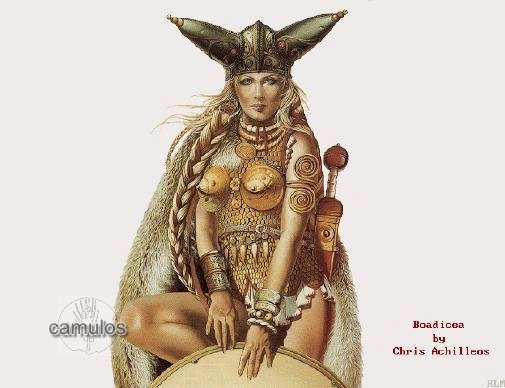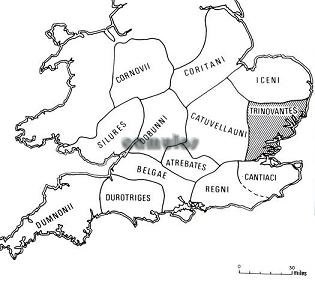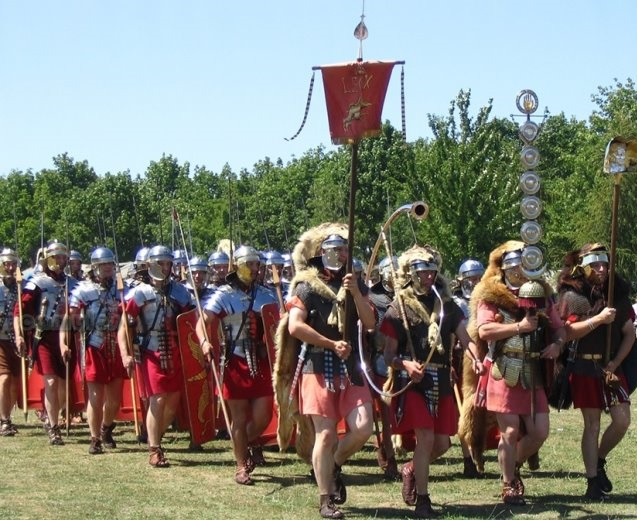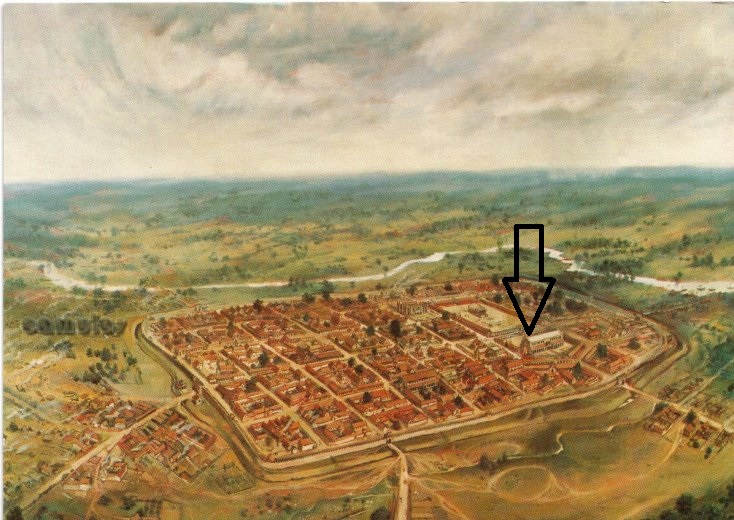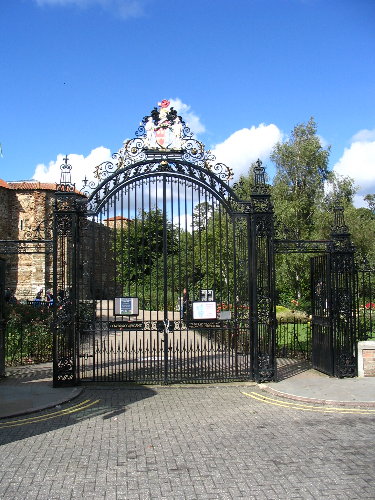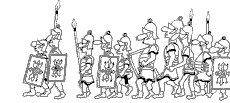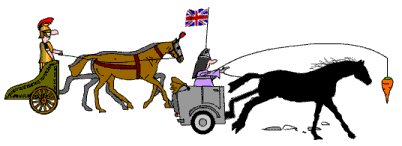Turning to the
left, the castle was built by the Normans around 1070, as part of
their defence system, following their invasion of England in 1066. It
is an impressive structure - indeed the largest Norman keep ever
built. Its size is due to the fact that it was built around the
podium of the Temple of Claudius, destroyed by the Iceni Queen
Boadicea in AD 60 or 61 and then rebuilt, only to fall into decay
after the Romans left Britain around the year 410.
If you look up at its
walls, there are several points worthy of mention.
11 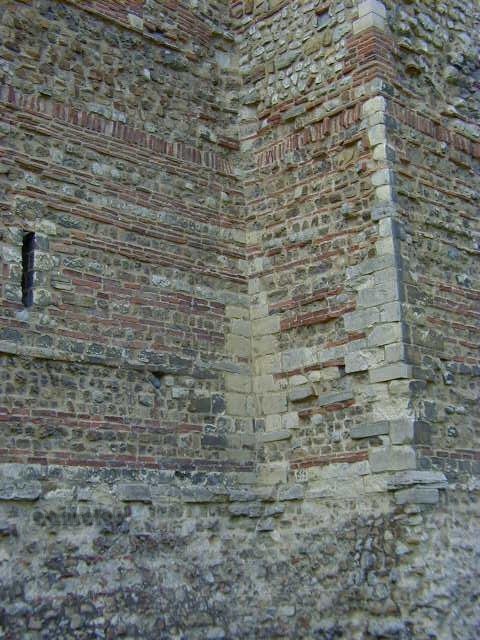
Firstly, the Normans
soon discovered that Essex is devoid of any natural building stone.
The Romans had found the same thing some 1000 years earlier and had
used a material called septaria which was mined locally, with some
having to be brought from the coast. Natural red earth (boulder clay)
was in abundance and from which they made their tiles. The lime for
the mortar would probably have come from Kent, or perhaps Norfolk,
where chalk deposits were. The Romans would have brought-in
particular stone for certain important buildings, from wherever they
found it, some perhaps from the continent. It could be concluded that
the Normans very efficiently destroyed any carved or engraved
stonework that the Romans had created, as so very little has been
discovered in recent times.
The castle is built
almost entirely from reclaimed Roman materials; Roman roof tiles
being in abundance and heavily used in the walls. The large windows
on the south wall are not original. They were put in by Charles Gray
in the 18th century, to give more light, replacing the smaller Norman
slit windows that would have been there and which can be seen
elsewhere on the building.
A previous owner of
the castle was a man named Wheely, who had bought the building in
1683, for the sole purpose of demolishing it and selling off the
materials for building works. Thankfully, the task defeated him and
he went bankrupt as a result. Perhaps the only good thing that came
out of Wheely's destructive activities was the discovery of the
castle's biggest secret. Underneath its walls, was found what has
subsequently been identified as the plinth on which the Temple of
Claudius was built in the 1st century AD - but I will leave that bit
of our story for you to find on our Colchester Castle
page.
It is believed, the
height of the castle as you see it today is about what it was when it
was first built, although the corner battlements have mostly
disappeared, probably easy work for Wheely's men to destroy.
Incidentally, our castle predates, and is built double scale to, the
famous Tower of London. That building has fared better with the
passing of time and is a good indicator of how our castle must once
have looked.
Again, lingering at
the walls, it is quite clear that the castle was built in more than
one stage. An extra storey was added at some point, evidenced by
filled in battlements in various places and different style of corner
stone work (quoins). The roof gives an impression of an Italian style
and is not original. Charles Gray had believed his castle to be Roman
and so saw fit to put a Roman style roof on it.
Following on around
the west side of the castle and looking up again to the walls, there
can be seen a sycamore tree growing on the ramparts, said to have
been planted by the gaoler's daughter, some 200 hundred years ago.
The castle served as the town's gaol (jail) for many years. Also, the
west wall is basically as it was when the castle was first built,
with its tiny slit windows, which gave light internally and kept the
worst draughts away. Also in this wall are various outfalls from the
garderobes, the toilets! The round cupola on the top was built by
Charles Gray and is in the position where one of the castle towers
would have stood. It seems likely that Mr Wheely demolished these
towers prior to Charles Gray's rescue.
Colchester High
Street still follows the line of where the Romans put it, although it
bows out to the south, probably to accommodate the Norman period
bailey wall of the castle. A good deal of the 2800 metre long Roman
wall (the only one around a town that still survives) can be seen
today. Since Roman times, most events in Britain's long history have
left their mark on the town.
For more detailed information
about the castle, inside and out, please visit our Colchester Castle
web page.

THE CASTLE PARK
So, let's take a walk
around our award winning Castle Park, starting at the water
garden.
12 
(taken September
2016)
15 
A FOLLY -
NOT ROMAN OR NORMAN (taken
September 2016)
16 
One of our flower
beds, this one commemorating 100 years of the Cubs.
(taken September
2016)
The Castle Park's
gardeners do a wonderful job in creating these displays.

THE OBELISK
17 
18 
Walking round to the
rear of the castle, we find an obelisk dedicated to the two soldiers
martyred by the Civil War, when Colchester was under siege by Lord
Fairfax, one of Oliver Cromwell's generals, in 1648.
The town underwent
much hardship during the siege which lasted all through the hot
summer and, upon surrender by the Royalist army, Lords Lucas and
Lisle were executed by firing squad on or near this spot. It is
said that grass has never grown there since, although the tarmacadam
surface may have had something to do with that.
19 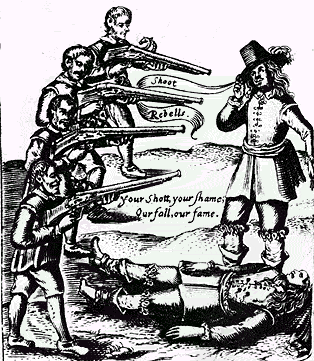
Colchester recovered,
the King was restored to the throne, Cromwell was dug up and his
remains put on display, many who had signed the king's death warrant
(not Lord Fairfax - an interesting story there!) were executed, and
the monarchy has been jealously protected ever since.
God Save the
Queen!

AVIGNON GARDENS
and RAMPARTS
Climbing up the hill,
which were once part of the Norman outer defences to the castle, we
have a magnificent view to the north and down into what we call the
Lower Castle Park. The gardens directly below are the Avignon
gardens, in recognition of the French town by that name, with which
Colchester is twinned. We are also twinned with Wetzlar in Germany,
with the associated gardens close to Hollytrees, where we have just
been.
20 
A view from the
Castle Bailey looking west.. (taken
September 2016)
21 
Several views from
the Castle Bailey wall, of our Avignon Gardens, named after one of
our twin towns. (taken
September 2016)
22 
(taken September
2016)
23 
(taken September
2016)
24 
(taken September 2016)

OUR REMEMBRANCE GARDENS
TO REMEMBER THOSE WHO SERVED IN VARIOUS CONFLICTS
PLACED BY OUR VARIOUS ASSOCIATIONS
25 
26 
27 
27a 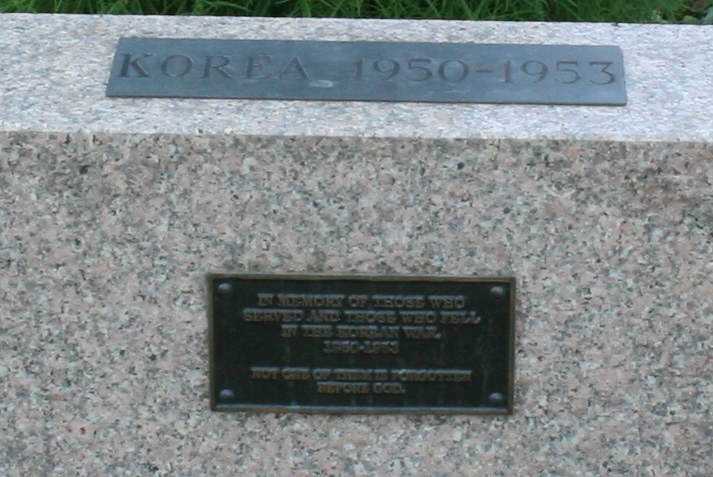
KOREA 1950 -
1953
28 
29 
29a 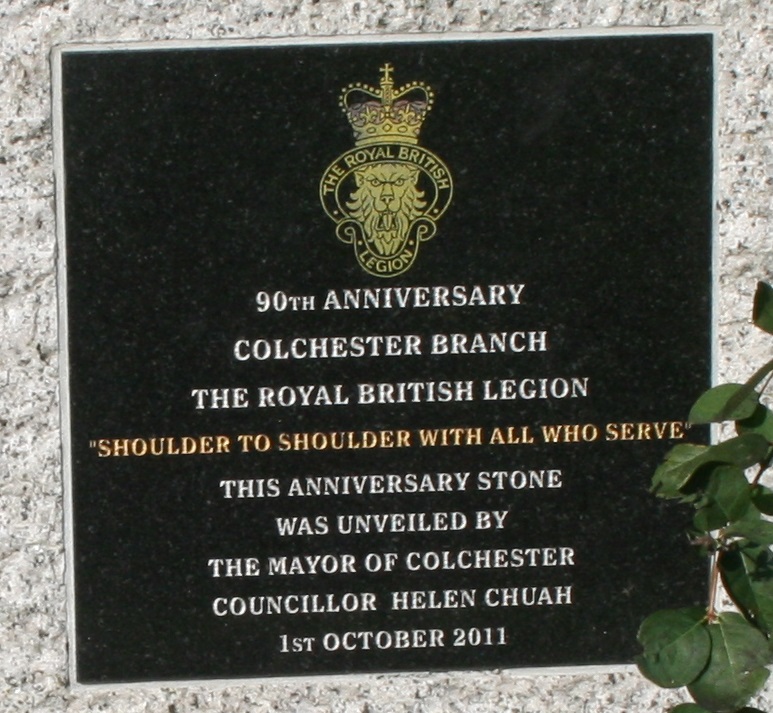
ROYAL BRITISH LEGION
30 
31 
31a 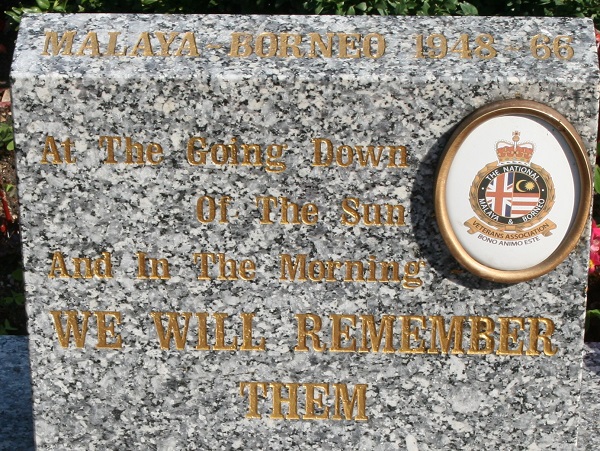
MALAYA BORNEO 1948
- 1966
32 
32a 
32b 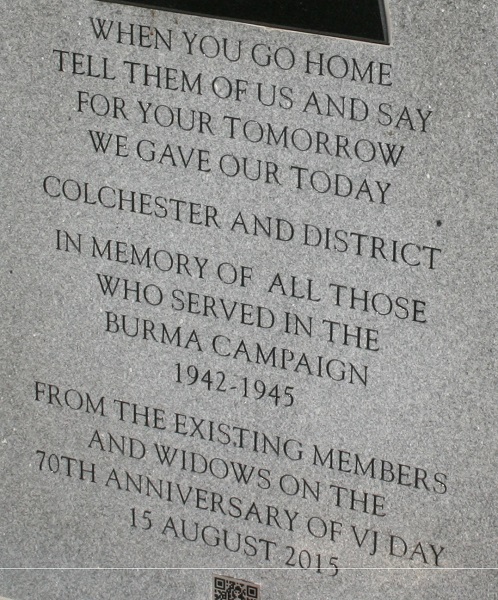
BURMA STAR ASSOCIATION
(taken
September 2016)
We will now pass
through a gate on the west side and out of the Castle Park.

ST HELENA'S
CHAPEL
We now pass through a
small gate to the west of the castle and through into Maidenburgh
Street. Once through the alley way, to the left, is St Helena's
Chapel. Note how the Roman building method from the town wall has
been mimicked by the Normans in the chapel's walls, with regular
courses of Roman tile and septaria courses being used for the walls -
some 800 years later.
Records mention the
chapel's repair in 1097, but we are unsure exactly how old it is. It
stood unused as a chapel for many years, but, in the 2000s, become
used once again as a place of worship. It became the home of the
Greek Orthodox Parish of St Helen. It started life as a chantry
chapel in medieval times - King Henry VIII's reformation closing it
in the 16th century. A chantry chapel, where priests were paid a sum
after a person's death, to say prayers for that person, to help him
on his way to heaven. lt was later taken over by the Quakers. Note
the traffic bollards close by with the town's crest on them.
St Helena is
Colchester's patron saint, said to have been the daughter of King
Coel, married to the Roman Emperor Constantius and mother of the
Emperor Constantine who, in 333AD declared that the Roman Empire
would become Christian. She was further said to have travelled to the
Holy Land, to have discovered a fragment of the cross of Jesus and to
have discovered the burial places of the three wise men. Apparently,
when she returned to Britain with the relics, the cross fragment
started to sprout into life. This is why our crest shows a sprouting
cross and three crowns. (Incidentally, we have the same crest as
Nottingham.)
33 
34 
35
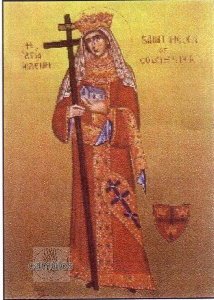

THE ROMAN
THEATRE
Archaeological
excavations in the 1980s discovered that St Helena's Chapel is built
on the Roman foundations of the colonia's theatre (no good Roman
colonia or town would be without one), the outline of which is now
picked out in darker bricks along the roadway (not that is very clear
now).
36 
The pictures shows
the information board outside the building where part of the
foundations are displayed and inside, where the picture describes how
the 3000 person capacity theatre would once have been. The amazing
fact is that there are only five known Roman period theatres in
Britain - and Colchester has two of them.
37 
We should point out
that Colchester was a place where great entertainments were held.
London (Londinium) may well have taken over as the Roman capital at a
later date, but Colchester was undoubtedly the most magnificent of
all Roman settlements in Britain. In 2005 archaeologists identified
the only known Roman circus to be found in Britain, one of the
largest outside of Italy and one of only two north of the Alps. OK,
we still have not definitively found the baths (or have we?) that
must have been here, nor an amphitheatre (why would one have existed
in the peacefull colonia?) where gladiatorial combats would have been
held, but this is only a matter of time, surely? This theatre would
have been used for entertainment of various sorts, plays, poetry,
reading, debates, socialising, etc. This was a town where the Romans
and their friends could relax and enjoy themselves.
Indeed, Roman
Camulodunum must have been a place of peace, leisure and
entertainment for its inhabitants.
38
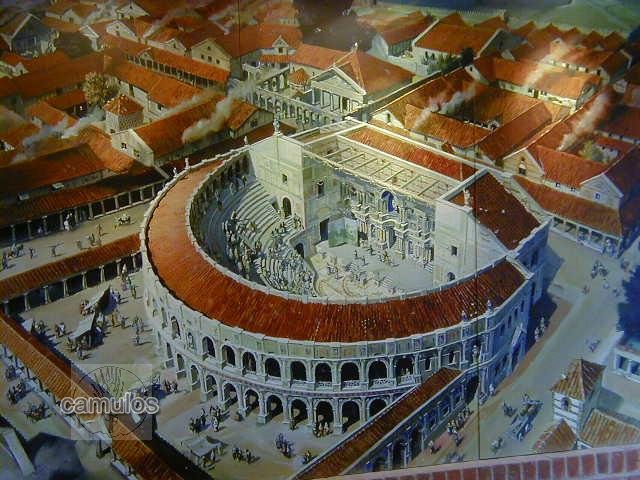

QUAKER BURIAL GROUND
Walking back to the
chapel and turning left along William's Walk, we pass what once was
the town's Quaker burial ground, now given over to grass, but with
some gravestones set against the perimeter walls.
39 
40 
Colchester, like so
many other towns, had (and still has) a strong non-conformist
following (ie non Church of England protestantism).

THE DUTCH QUARTER
41 
At the end of the
street, we find ourselves in an area of 16th and 17th century timber
framed buildings, an area known today as the Dutch Quarter. This is
slightly misleading as it was in this area that the Flemish settlers
lived, evading religious persecution in their own country. They were
heavily involved in the wool trade and weaving industry, something
that was very important in Colchester for several centuries, before
the industrial revolution of the 18th century reduced it to a
trickle. Note how several of the houses have large ground level
windows, designed so that the weaver could get maximum light whilst
working at his loom.

JOHN BALL and
WAT TYLER
It was in this
general area that John Ball, the famous anarchist who lead the 14th
century Peasant's Revolt lived, and his compatriot Wat Tyler. The
revolt was against the rich who controlled the wages paid to the
peasants, the latter believing themselves to be worth much more. So
what has changed?
...or was it the
Pedant's Revolt?
42 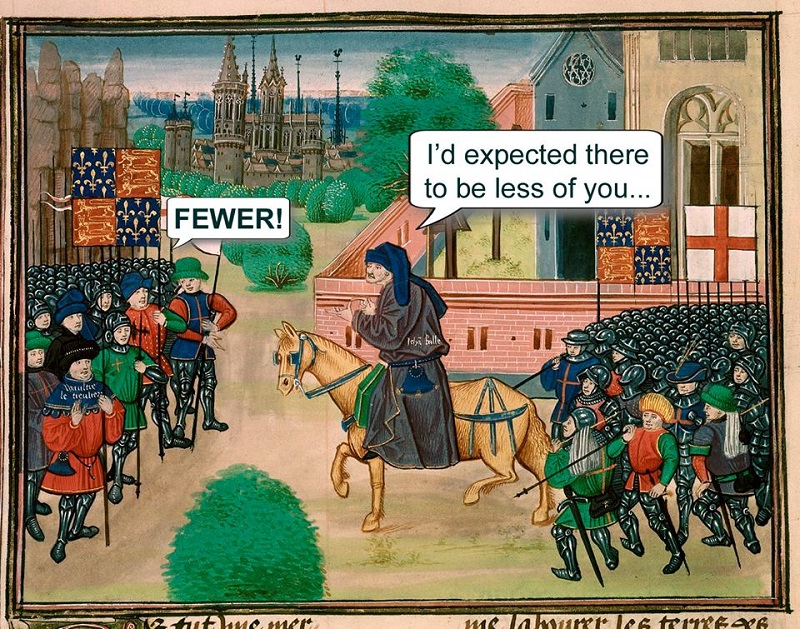

STOCKWELL CHAPEL
As we walk on, we
find Stockwell Chapel, where Isaac Taylor once lived and preached,
before fleeing with his family to escape the expected invasion by
Napoleon Bonaparte in the early 19th century. More about the Taylor
family later. This area of Colchester had several non-conformist (not
allied to the established Anglican church) chapels. Their
congregation were known as dissenters by the Anglicans and they were
persecuted (as were the catholics) for many decades,
nationally.
43 
This is further
evidence of the non-conformists in the area, where philanthropic
activity also created schools for the children of the area.
44 
45 
Across the road from
the chapel is a building that was once our Bluecoat School. A
Bluecoat school was a type of charity school, the first of which was
founded in the 16th century, named as such because of the distinctive
blue uniform originally worn by the pupils. The colour blue was
traditionally the colour of charity, and was a common colour for
clothing at the time. The uniform included a blue frock coat, and
yellow stockings with white bands.
46 
Bluecoat School, now
in private use.
47 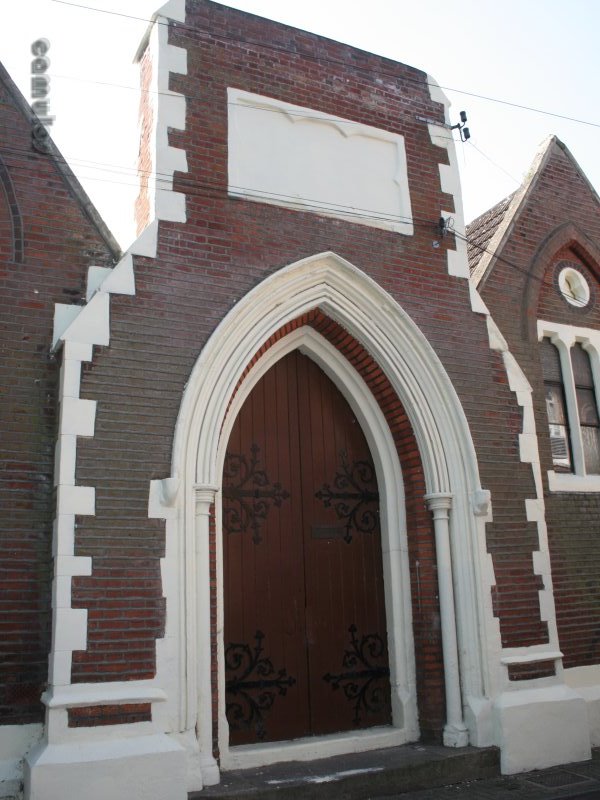
48 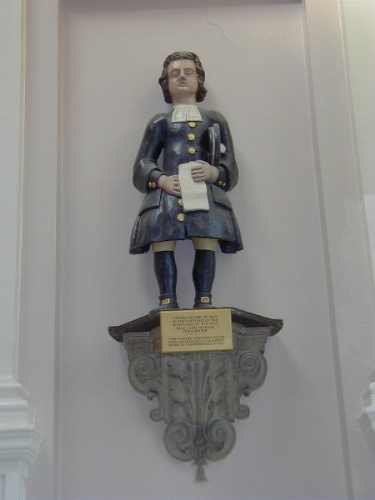
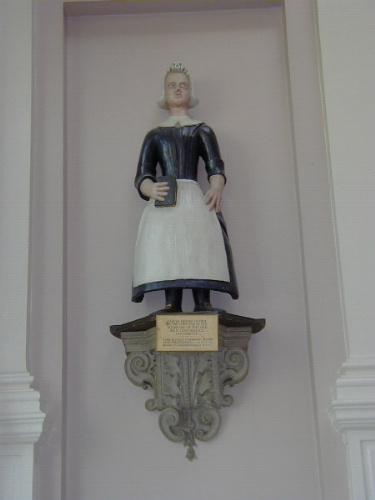
These two statues now
reside in the Town Hall and are understood to have come from the
Bluecoat school in Colchester.

The name Stockwell is
a reference to the place where people on this side of the town came
for water, as Colchester is built on a free draining hill, with
impervious clays at its foot. This was where the water settled and
the level to which wells had to reach, including the deepest of them
all - inside the castle. This is further evidenced by the fact that
Colchester's several (now sadly all gone) breweries were located in
divers directions at the foot of this hill.
~~~~~~~~~~~~~~~~~~~
We finish this part
of our tour here. Please proceed to the next stage of your Virtual
Tour by clicking on:
